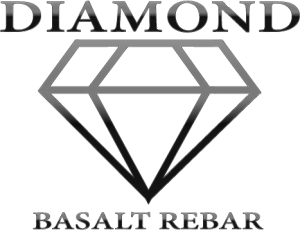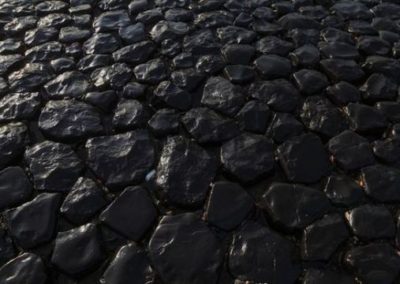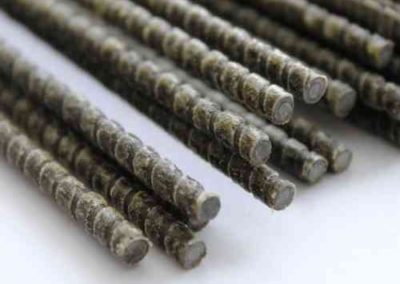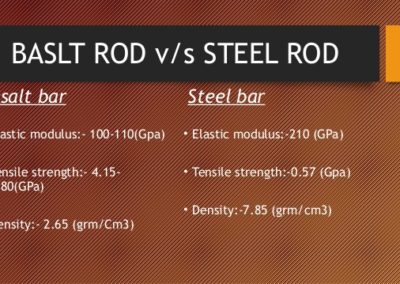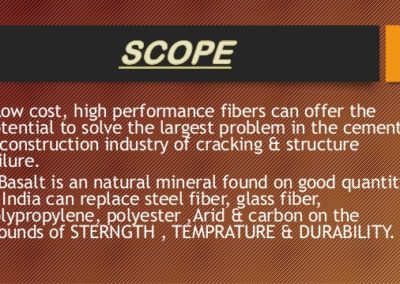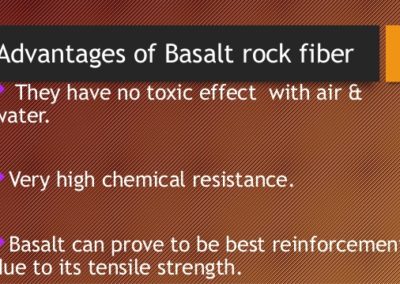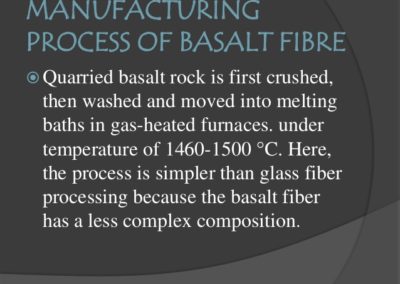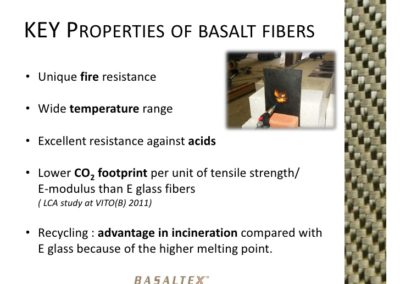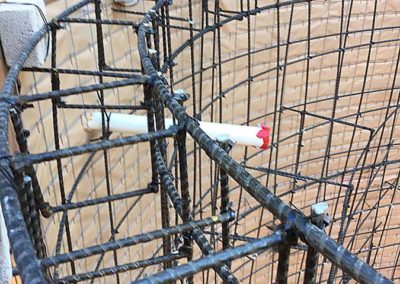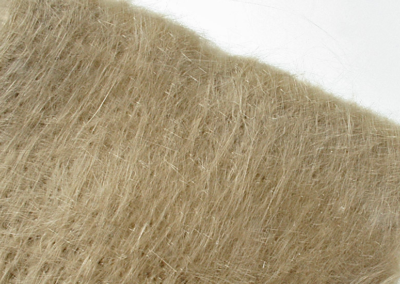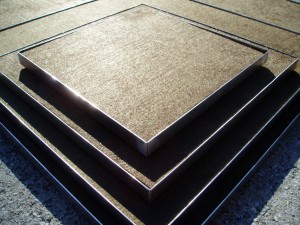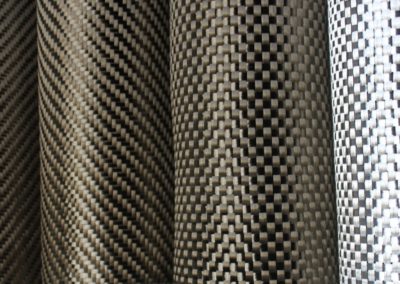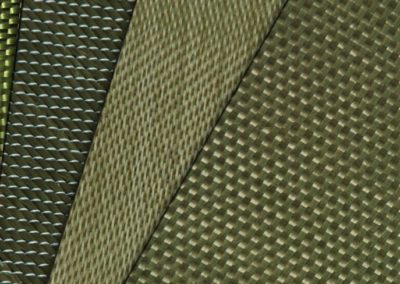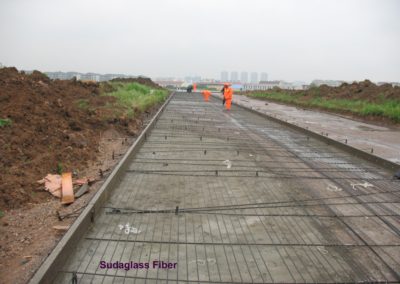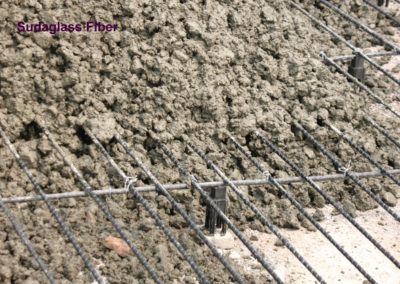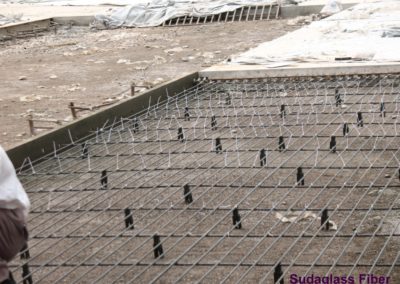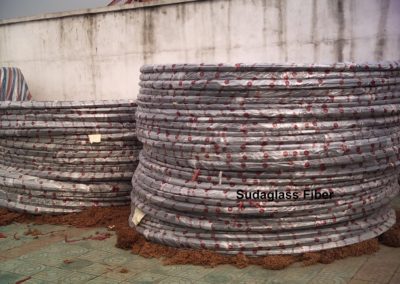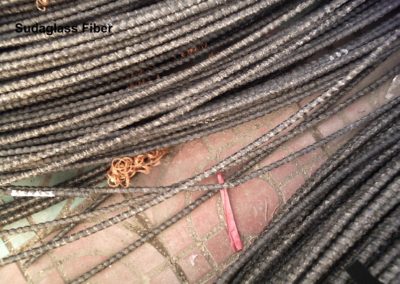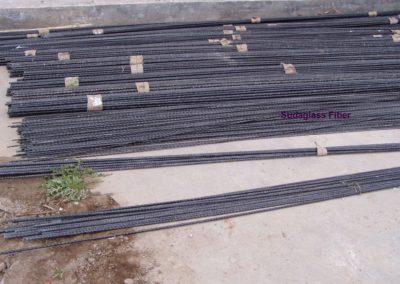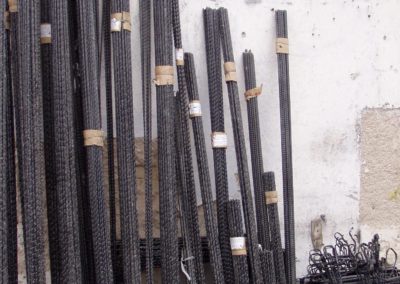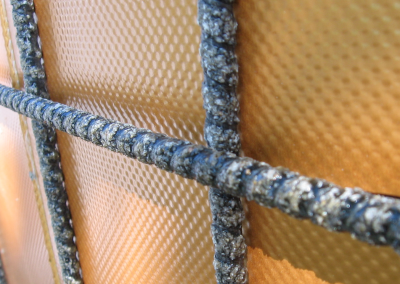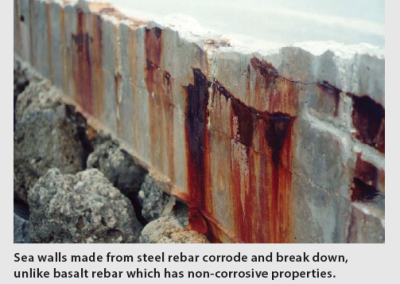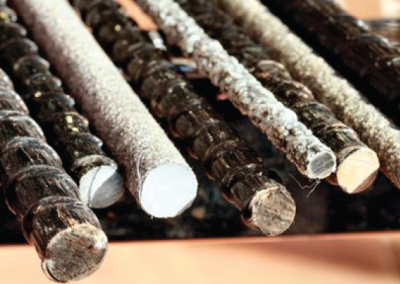Rebar
Why not use regular steel rebar?
The biggest factor with rebar is avoiding corrosion. A particular concern is rebar that spans a cold joint in the concrete. There will be a cold joint between the footing slab and the bottom of the ICF wall and in the wall between stories. Cold joints let in water as fresh concrete does not stick to hardened concrete. Latex bonding agent can be used between pours and is worth doing, but even so it is worth assuming that water can get in the joint.
When steel rebar rusts it expands and this splits open the concrete letting yet more water in that causes even more rusting. This fairly common concrete failure mode is called spalling. Using steel rebar is not compatible with a house designed to last 500 years.
Other possibilities
Galvanizing
If using steel rebar then certainly I believe it should be galvanized to stop it rusting. It is best to have it galvanized after you have cut it and bent it. Galvanizing companies exist in most areas so you should find a local one. They seem to charge by weight (even though it would seem more logical to charge by surface area). Overall, galvanizing is an expensive choice.
Fiberglass rebar
Fiberglass rebar is a much better choice than steel rebar. It is available from two American manufacturers, but they charge three times the price of steel rebar. A better bet is to buy it from one of the many manufacturers in China. Even with shipping, it is only about the same price as regular steel rebar.
There is some question about whether fiberglass rebar is stable in the alkaline environment of concrete. A Canadian study on bridges had some doubts. In contrast, basalt rebar does not need a special coating to resist the high ph from exposure to concrete like fiberglass rod requires.
Vinyl ester resin is used to bind all the glass fibers together. Vinyl ester resin does provide some protection from alkalines.
Typical fiberglass rebar of 12mm diameter has this spec:
Weight: 0.22±0.05kg/m
Tensile strength: ≥500MPa
Shear strength: ≥100MPa
E-modulus: 35-45GPa
Elongation: 1.5%~2.5%
Basalt Rebar
My conclusion is that basalt rebar is the best choice for all the reasons described below.
Basalt Rebar
How basalt rebar is made
Basalt is rock
Basalt rebar is made from volcanic rock called basalt. Magma in the earth’s core is basalt. Basalt has the following chemical composition…
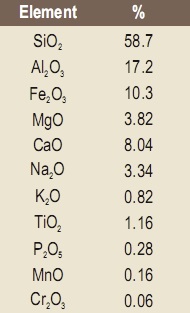
Melt the rock to make fibers
Basalt fibers are manufactured in a single stage process by melting pure basalt rock raw material. Basalt filaments are made by melting crushed volcanic basalt rock of a specific mineral mixture to 1,700 degrees Celsius for 6 hours. The white hot material is drawn through special platinum bushings and then cooled into fibers. The fibers cool into hexagonal chains resulting in a resilient structure substantially stronger than steel or fiberglass.
Fibers set in epoxy
Basalt rebar is manufactured from continuous basalt filaments and epoxy polymers. Basalt rebar consists of 80% fibers and 20% resin.
Wound spiral to provide concrete grip
Adhesion to the concrete is typically done using a wound spiral “thread”, but surface embedded sand can be used instead or in addition.
Use molds to make bends and stirrups
Basalt rebar cannot be bent on site. Stirrups (specified by structural engineers to form lintels and wall columns) involve many corners, eg 90, 135, and 180 degree bends. Bends are done during the manufacturing process.
Advantages of basalt rebar
Not harmed by harsh environments
Basalt rebar does not corrode. It was specifically developed for harsh environments such as sea walls and road bridges. One of the major problems the construction industry faces today is corrosion of reinforcing steel, which significantly affects the life and durability of concrete structures. Basalt rebar effectively counters this problem because it is immune to corrosion.
Stronger than steel rebar
Basalt rebar provides high tensile strength. Basalt rebar is about 2.5 times stronger (tensile strength) than series 60 steel rebar of the same diameter.
Stronger than fiberglass rebar
The tensile strength of continuous basalt fibers is about twice that of E-glass fibers and the modulus of elasticity is about 15-30% higher.
High chemical stability
Basalt fibers in an amorphous state exhibit higher chemical stability than glass fibers. When exposed to water at 70 degrees C (158″ F), basalt fibers maintain their strength for 1200 hours, whereas the glass fibers do so only for 200 hours.
Thermal expansion coefficient similar to concrete
The thermal expansion coefficient is very close to that of concrete (whereas steel is very different). This avoids concrete cracking.
Completely non-toxic
Basalt rebar is environmentally safe and non-toxic. It is also completely inert. The production process creates no environmental waste and it is non-toxic in use or recycling.
Lighter weight than steel
Basalt rebar is about a third of the weight of steel and given that it is 2.5 times stronger than steel, then its strength to weight ratio is 7.5 times better. This makes it far easier to use and less expensive to ship.
Can be used in thermal breaks
For implementing things such as thermally isolated balconies, basalt rebar allows the balconies to be structurally attached without heat loss from the internal building structure.
Does not conduct electrically
The basalt fibers have good insulating characteristics.
Safe in house fires
It does not loose strength in a house fire situation (it can stand 600 degrees C quite happily). The basalt fibers have high heat stability.
UV resistance
Basalt is naturally resistant to UV exposure (although the epoxy resin can be harmed by UV).
Elasticity characteristics
Basalt rebar has a low young’s modulus compared with steel, but is 15-30% higher than fiberglass rebar. It is strong in tension and has very little stretch.
If rebar is subjected to beyond the spec limits then it will break rather than stretch. The rebar placement design needs to allow for this. The structural engineering needs to consider “tensile modulus”. In a properly structurally engineered design, the rebar will not be subjected to anything like the force needed to break it.
Using Basalt Rebar
Stirrups and bends
You need to use separate corner pieces and attach them with a 20x diameter overlap to the straight pieces. Where stirrups are needed they need to be manufactured in the factory. Information on stirrup design and all aspects of designing with basalt rebar is at Basalt Rebar Structural Design .
Testing
Basalt rebar is currently being tested at various universities. I also had it tested myself at an ASTM accredited test house.
The testing I had done allowed it to be approved by the local building authority. This specific testing was necessary because there are not yet any ACI specs that specificly relate to basalt rebar (as it is too new). Unambiguous approval of basalt rebar by the American Concrete Institute is expected within 18 months. The plan is for it to be covered under ACI 440-10.
Various studies
https://provenperformancechemical.com/pdf/University_of_Akron_Oh_Basalt_Testing.pdf
http://www.basaltex.com/files/cms1/Basalt-Fibres-as-reinforcement-for-composites_Ugent.pdf
http://www.newrebar.com/
http://www.newrebar.com/articles
http://www.newrebar.com/technical_information
http://www.usbasalt.com/composite-rebar.html/a>
http://fiberglassrebar.us/basalt-rebar/
http://www.build-on-prince.com/fiber-reinforced-polymers.html#sthash.DKBwdeDj.dpbs
http://www.provenperformancechemical.com/pdf/Basalt_Study.pdf
http://www.compositesworld.com/articles/composites-and-concrete
ACI codes
To be allowed by your local building inspector department to use basalt rebar it is likely to be necessary to reference the various ACI codes that apply. Here is the statement that applies to Basalt rebar…
Basalt FRP rebar is used as per ACI 440.1R-06. The construction use is dictated by code 440.6-08. It is specified by 440.5-08 and tested according to ASTM D7205 and several other test methods. ASTM testing of Basalt FRP rebar shows that Basalt FRP rebar easily meets the performance requirements of ACI 440.6-08.
Also applicable to Basalt rebar is ACI 440R-07 “Report on Fiber-Reinforced Polymer (FRP) Reinforcement for Concrete Structures”. The use of Basalt rebar came along after ACI 440.6-08 was published so the Basalt version of FRP was not specifically called out in that document. However, ACI 440R-07 (a later document) does specifically call out Basalt rebar as an FRP rebar. It says “Fibers commonly used to make FRP bars are glass, carbon, and aramid. Recently, continuous Basalt fibers have become commercially available as an alternative to glass fibers.” It talks about Basalt FRP rebar all through the document and includes it in its various tables, but the key point is that it is classed as FRP.
Basalt FRP rebar is approved as natural fiberglass, meeting the certification specifications of ACI 440.6-08 and signed off as fiberglass FRP rebar. In doing so, the job will simply be overbuilt because the physicals of Basalt rebar are higher than fiberglass, falling between fiberglass and carbon fiber.
Basalt rebar can be placed to meet code requirements by using the calculations and installation guidelines for fiberglass reinforcement of concrete as defined in ACI 440.6-08.
Recommendations for maximum deflection and shear of concrete elements reinforced with fiber reinforced polymer (FRP) rebar’s are presented in ACI 440.1R-06 (2006) “Guide for the Design and Construction of Structural Concrete Reinforced with FRP Bars”.
Basalt rebar has been tested at various universities and approved by the American Concrete Institute under ACI 440-10. Basalt rebar is used according to ACI 440. 1R-06. The construction use is dictated by code 440.6-08. It is specified by 440.5-08 and tested according to ASTM D7205 and several other testing methods.
Basalt rebar has been tested by several methods and approved by ISO 9001.
In the ACI documentation, the term FRP (Fiber Reinforced Polymer ) includes Basalt based FRP. The term BFRP is often used instead of saying Basalt Rebar.
The conclusion from all the documentation is that Basalt rebar is FRP rebar and can be treated and approved as FRP rebar.
Even though theoretically you could submit the rebar to the ICC for certification and it would pass, in practice this is an expensive process and rebar manufacturers all work to ACI (American Concrete Institute) standards and guidance instead. Even Hughes Bros that is the foremost American manufacturer of FRP rebar does not use ICC.
Applicable standards
American Concrete Institute standards
ACI 440.3R-4 “Guide for the test methods for fiber reinforced polymers for reinforcing or strengthening concrete structures”
ACI 440.1R-06 “Guide for the design and construction of concrete reinforced with FRP Bars”
ACI 440R-07 “Report on Fiber-Reinforced Polymer (FRP) Reinforcement for Concrete Structures”
ASTM Standards
A 370 “Tensile Tests (Structural or Reinforcing No. 3 through No. 7)”
D 7205 “Standard Test Method for Tensile Properties of Fiber Reinforced Polymer Matrix Composite Bars ”
D 570 “Standard Test Method for water absorption of plastics”
D 619 “Standard practice for conditioning plastics for testing”
D 695 “Standard test method for compressive properties of rigid plastics”
D 790 “Standard test methods for flexural properties of unreinforced and reinforced plastics”
D 792 “Standard test methods for density and specific gravity”
D 2734 “Void content of reinforced plastics”
D 3410 “Standard test method for compressive properties of polymer matrix composite materials”
Design Manuals
Isis Design Manual No 3: Reinforcing concrete structures with fiber reinforced polymers
Committees
American Concrete Institute (ACI): 440 – Composites for Concrete
American Concrete Institute (ACI): 400H – Reinforced Concrete (rebar)
American Concrete Institute (ACI): 440I – Pre-stressed concrete (tendons)
American Society of civil Engineers (ASCE): Structural Composites and Plastics
American Society of Testing and Materials (ASTM) : ASTM D20.18.01 – FRP Materials for concrete.
American Society of Testing and Materials (ASTM) : ASTM D20.18.02 – Pultruded Profiles.
American Society of Testing and Materials (ASTM) : ASTM D30.30.01 – Composites for Civil
Other
AASHTO Bridge Subcommittee: T-21 – FRP Composites
Price
The price of basalt rebar is coming down as the production volumes increase. Currently it is more expensive than Chinese fiberglass rebar, but less expensive than American made fiberglass rebar.
Buildings built with Basalt Rebar
Center for Nanoscale Material
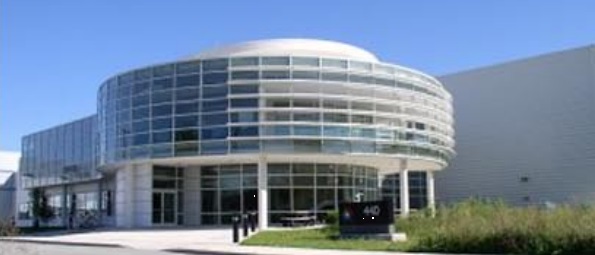
This US Department of Energy government owned concrete multistory structure in Illinois is entirely reinforced by Basalt Rebar.
Carnation House
My house in Carnation WA is the first house in America to use basalt rebar.
Structural engineering
Rather than lots of rebar, it is better to have the smallest amount of rebar (ie thinnest and widest spacing) so that it can be higher quality rebar. You need to find a structural engineer that does not overdesign but rather properly calculates.
Also need to find a structural engineer that is prepared to use basalt rebar rather than steel.
Rebar placement and thickness will be given by the structural engineer. He will also specify what stirrups are needed. The rebar diameter and placement will be different compared with steel rebar.
See Basalt Rebar Structural Design .
Design characteristics
For the same shape and same load, corrosion-proof rebar will deflect, elongate, or compress more than steel. This is the main design difference. It can mean more basalt rebar will be needed to form a lintel.
Neither fiberglass rebar or basalt rebar can be bent on site. Bends and stirrups need to be manufactured in the factory using a specific mold. According to CPPI, in the case of fiberglass rebar, 50-60% of the guaranteed design strength of a straight bar is retained after making a 90 degree bend.
Ideally it’s useful to have a bend in the end of straights. In my case, concrete floors are at the top of all walls, so it is good to have the rebar bend down into the walls.
Fiberglass rebar must be designed per ACI 440.1R-06, direct substitution from steel to fiberglass or basalt rebar is not appropriate due to differences in physical / mechanical properties.
The golden rule for splicing (lapping) and that is the lap should be no less than 30 times bar diameter. For example #4 = 1/2 inch times 30 = 15 inch lap.
When using basalt rebar the need for spacing between the rod and the surface of the concrete is reduced to only 3/4″ as per ACI 440-6.
See Basalt Rebar Structural Design .



